 |
 |
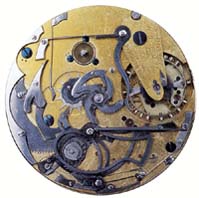 Minute repeat mechanism on a 19th Century gentleman's watch |
Horology
The collection is founded upon the Gershom Parkington Collection, bequeathed to Bury St Edmunds Borough Council in 1953 by Frederic Gershom Parkington in memory of his son John, who was killed in the Second World War. The collection includes sundials, clocks, watches, mechanisms and clockmakers' equipment. Additions have continued to be made ever since, and it now comprises one of the finest public collections of time-measurement instruments in the world.
This collection has been housed in several buildings during its time on display. From 1953 until 1993 it was located in 6 Angel Hill, otherwise known as Angel Corner, Bury St Edmunds, a Queen Ann house owned by the national Trust. After a series of serious burglaries, the collection was moved to the Manor House on Honey Hill in 1993. In 2007 the Manor House changed from a museum into a private dwelling, and the timepiece collection moved to Moyse's Hall Museum on the Cornhill in Bury St Edmunds.
|
 Universal equinoctial crescent dial by John Martin, c 1700  Silver universal ring dial by Helkiah Bedford of London, 1675 |
PORTABLE SUNDIALS On a bright day a fixed object casts a shadow that moves as the sun moves across the sky; the same is true on a bright moonlit night. Measuring the varying length and position of the shadow is perhaps the earliest concept in time measurement, dating from thousands of years before mechanical devices. The earliest sundials, like Cleopatra's Needle, were upright obelisks, but in order to measure true solar time, the angle of a sundial's spike, or gnomon, must correspond with the angle of latitude. Therefore, any dial made for Bury St Edmunds must be set at an angle of 52 degrees. Portable dials require some means of adjusting the gnomon in different locations if they are to give a correct reading. The majority had a built-in compass for more accurate alignment, and many styles from the Continent and the Far East are included in the collection. The sophisticated multi-functional, ivory diptych dials of Nuremberg do more than just tell the time, they also convert lunar shadow to solar time. Perhaps the most elegant dial is the silver universal ring dial by Helkiah Bedford, which requires no compass and folds flat in the pocket. It was made around 1675, a time when new technology was advancing the mechanical watch to new standards of accuracy, and the decline of the pocket sundial was already underway. |
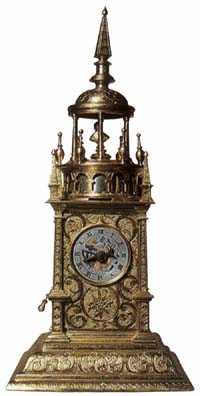 Gilt tabernacle clock by A. Meyer, Augsburg, c. 1600 |
RENAISSANCE CLOCKS From the sixteenth to the early seventeenth century, one of the largest centres of clock manufacturing in Europe was in Augsburg, Bavaria. Drawing on the skills of the armourer and locksmith, the coiled steel spring was increasingly used as the motive force for domestic clocks. The gilded opulence of these clocks reflects the exuberance of the High Renaissance. The horizontal table clock in a case has the simplest style, while the more extravagant tabernacle clock has two or three dials, and its case is surmounted with a tiered rotunda containing bells for hourly and quarter-hourly striking. Augsburg was the centre of the Counter-Reformation, and the images of Catholic Christendom are frequently found in clocks made there, examples of which are the Virgin Mary, whose crown revolves to record the quarter hours, and the crucifix clocks with revolving globes. Many clockmakers specialised in mechanisms for automata, and the museum's collection includes examples of the simpler kind: the lion clock and the chattering skull clock. The Thirty Years War ended Augsburg's reign as the city was besieged and sacked. Before its position could be recovered, it had been over-taken by London as the premier clock-making centre of the world. |
 Marquetry longcase clock by Richard Lyons of London, c. 1680 |
ENGLISH DOMESTIC CLOCKS Large public clocks began appearing in English monasteries towards the end of the thirteenth century, and as native clockmakers were in short supply many Continental craftsmen found employment here. At the beginning of the seventeenth century the first recognisable English clock - the lantern - had evolved. This quickly developed into an all-brass cased clock with a weight-driven striking movement surmounted by a bell and the dial having only an hour-hand. New pendulum technology, developed in the Netherlands in the 1650s, was quickly adopted and improved by English makers, and the longcase clock evolved naturally as a practical method of protecting the new, long pendulums. The earliest were small and narrow, but the beginning of the eighteenth century they had increased dramatically in height. Case styles evolved rapidly from the severe, ebonised style of Knibb to the more elaborate marquetry cases of Windmill, Lyons and Johnson, but the eighteenth century saw a return to the more subdued cases veneered in walnut and mahogany. By the nineteenth century, demand led to a reduction in their height, and the more general use of cheaper woods such as oak. Spring-driven table clocks probably evolved from the desire to make clocks portable within a large house, thus reducing the enormous cost of purchasing several individual longcase clocks. English 'bracket' clocks, as they are known, almost always have carrying-handles for this purpose. The magnificent ebonised, quarter-repeating example by Thomas Tompion has a strike/silent facility so that the bell can be silenced when required. Only a small part of the collection can be on display at Moyse's Hall at any one time.
|
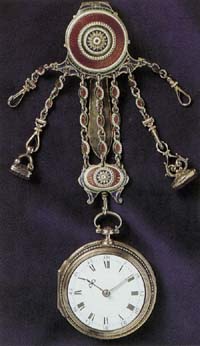 Gold & enamel watch and chatelaine by Ellicott of London, c. 1787
|
ENGLISH WATCHES Watchmaking developed late in England. The coiled spring, which had given . To clocks as early as 1450, had been followed by progressive miniaturisation, so that by the beginning of the sixteenth century the first watches were appearing in princely pockets. The early industry was dominated by Germany and France, but the persecution of Huguenot craftsmen following the Reformation led to a large influx of Continental skills into England. The first era was brief, snuffed out by plague in 1592 and 1598, but the foundations had been laid, and English craftsmen began to emerge. The year 1670 saw the transformation of the watch, pioneered by English makers, with the invention of the balance spring. This resulted in improved accuracy, allowing the minute-hand to be added. Decoratively, watches continued to be luxury items with leather and pique work, tortoiseshell and silver inlay and later luxurious repousse gold cases. Superb enamel cases appeared later in the eighteenth century. Improved escapement designs (the part of the watch that stops and releases the driving force) led to ever greater accuracy but as the nineteenth century progressed, English watchmakers failed to respond to competition from America and Switzerland so the standard pocket watch was increasingly imported. The 'John Bull' watch was a late attempt to capture the 'dollar' watch market, which failed. During the two world wars, the English watch factories largely switched to war production, and attempts to revive the industry in the 1950s failed. |
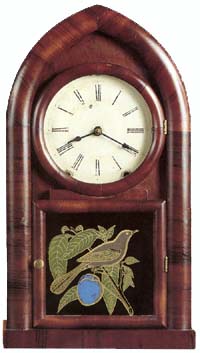 Round Gothic clock by the Brewster Manufacturing Company, c. 1845
|
AMERICAN CLOCKS (1800-60) Before the revolution of 1776, Americans were accustomed to buying manufactured goods from Europe, especially England, but political differences and the Napoleonic Wars disrupted this trade so that by the beginning of the nineteenth century clocks were being made in small workshops. Their design largely mirrored English styles. The transformation of clockmaking from a craft to an industry occurred in 1807 when the first factory opened in Bristol, Connecticut. As the country began to expand westwards, tall clock movements became difficult to transport so smaller shelf clocks began to be made. These initially continued to be weight-driven with wooden movements until the manufacture and introduction of brass. By the 1840's England's well established supremacy was to face a challenge from America that would overwhelm it completely. In 1842 Connecticut clock production had outstripped home demand, and Jerome began to export thousands of clocks to Europe. During the 1850s the dozens of small Connecticut companies amalgamated to become seven giants - Ansonia, New Haven, Waterbury, Seth Thomas, Ingraham, Gilbert and Welch - all of which survived into the twentieth century. However, the effects of the Depression, rising costs and foreign competition proved fatal, and between 1929 and 1967 they all ceased trading. |
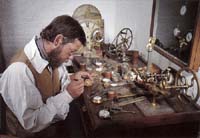 An 1850s clockmaker at his bench
|
THE CLOCKMAKER'S WORKSHOP
1850-1950: Clocks and watches, being mechanical devices, require attention from time to time, so every town in Britain had several 'watchmakers' (actually repairers) until present times, when their numbers declined as we moved out of the mechanical age. These pictures show two historic workshops separated by just one hundred years. There are many similarities between the two - the workbench with its many hand-tools has not changed for centuries. The most important piece of equipment, the lathe, is also a feature of both, mounted on its own bench and pedal-driven in 1850 but smaller and motor-driven in 1950. The 'official timekeeper', the regulator clock, was a fine precision instrument in 1850, but by 1950 was likely to be an electric master clock accompanied by a wireless for hearing the time-signals.
|
| Go to Museums Homepage | Updated 17 August 2009 | Go to Home Page |